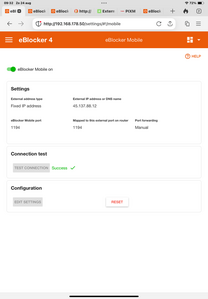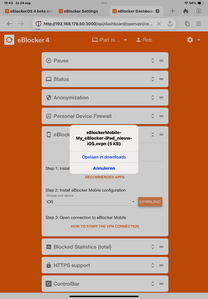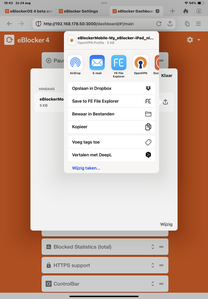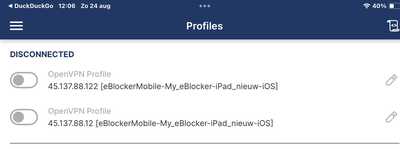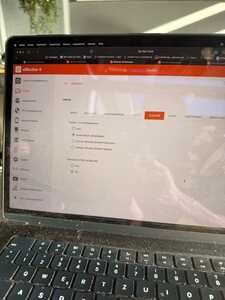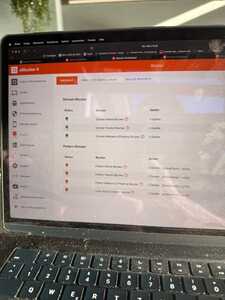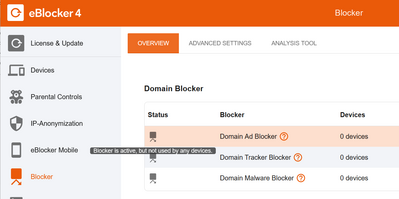Welcome tech-savvy beta-testers
eBlockerOS 4 (beta) is based on a completely new 64-bit operating system, and we've made extensive code changes to practically all components. Still, eBlockerOS 4 should function exactly like eBlockerOS 3.
We've tested the beta version thoroughly, and it's totally stable. However, the new version will probably have some bugs still. These need to be found during beta testing under real-world conditions.
We therefore invite all tech-savvy users to test eBlockerOS 4 beta in continuous operation (instead of eBlockerOS 3).
What you need for the test:
- Raspberry Pi 4 or 5 with at least 2GB RAM
(Raspi 5 recommended for Internet speeds >500 Mbit/s) - A new SD card with at least 8GB
(SD V30 speed class recommended) - Matching power supply for your Raspberry Pi
(3A power or more recommended) - Ethernet cable
(CAT 5 or higher recommended) - eBlockerOS 4 beta image for your platform
- Image download for Raspberry Pi 4 or Pi 5
SHA256: ded4c400ab48f0c8666de4b94719f1aa1c8da3f7ab9de46fcbffbd05836ecbf1 - Image download for Virtual Box
SHA256: f90f98a811d034ce1b3738c9eb65ede06747092c17cafa212ca6ab4dfb94498b
- Image download for Raspberry Pi 4 or Pi 5
To install the beta, just follow the regular Setup Instructions using the image linked above. After the initial setup, you can import a backup from eBlockerOS 3. However, please note that not all settings are backed up (yet). We are currently developing a complete backup for the final release.
If you find bugs that did not exist in eBlockerOS 3, please share them here in this thread.
Thank you for your support!
To start with, thank you Benne and the Team for creating and providing this beta. In France they say "chapeau bas".
As a non-tech-savvy i took the liberty to install eOS 4.0.2 on a Raspberry Pi 5 with 4 GB RAM. 'Prima vista', everything seems to work fine and no bugs found (yet).
One remark though: My White Cube was working without a SD card in its slot; when i disconnect the power of my Raspberry, remove the SD card and reboot again, the eBlocker is not available. After reinstalling the SD card again, the eBlocker is happy again. Is this normal?
Regards, Rob
Hi @robf,
yes that is normal. The White Cube has an internal SD card (eMMC). The Raspberry Pi does not have an internal disk, the external SD card is needed for running the eBlocker software.
There is a small issue in 4.0.2 if you change the network configuration in eBlocker's settings.
Due to a bug the wizard can not detect your router's DHCP service. As a result
- When you switch to individual settings you have to take care to really switch off your router's DHCP. The wizard does not warn you currently, if you forget to do that.
- When you switch back to automatic settings and you re-enable your router's DHCP, the wizard does not notice it. Simply wait for the timeout (a few minutes) and check the box "I have enabled the DHCP service of my router". Then you can continue.
We are working on an update which will fix this bug.
Re:eBlocker Mobile
Checked connection to router in Settings/eBlocker Mobile and switched server on. Both on iPhone 15 and iPad Air, installed Mobile-configuration in OpenVPN-app.
OpenVPN-app can't connect; used to work flawlessly on White Cube. Can somebody please check? Thank you.
@robf Please double check the port forwarding in your router. The Raspi has a different IP address than the White Cube.
You want to make sure to forward 1194 UDP to Raspi/eBlockerOS 4 IP address (can be found in the Dashboard Settings tile). Then eBlocker Mobile will probably work again. Nothing to do with eBlockerOS 4 btw.
THX!
However, please note that not all settings are backed up (yet).
Hi,
Is there a list of parameters that are not backed up?
Then I could document them manually (on paper) and re-enter them by hand.
@joe When you start the backup the parameters that are being backed up are shown in a dialog. Consider everything else to be missing still.
THX!
@random Good morning.
I (double-)checked before, but apparently there is still some homework to be done ... somewhere.
Will keep you posted. Rob
@robf You need to generate a NEW .ovpn file on the Raspi that needs to be imported in the target's OVPN client. Make sure to use this .ovpn file for connection - not he old. This should work then as the port forwarding is working well already! Good job.
THX!
@random Have been using a new .ovpn-file all along. To double-check, i reinstalled again...
Result is identical, no connection.
Would you be kind enough to check the log-file of the OpenVPN-app? Maybe the answer can be found there.
Thank you, Rob
Basically, these settings are backed up:
- Device settings
- Tor settings
- Trusted apps
- Trusted websites
- HTTPS certificate (if you check the box and set a password for the backup)
These settings are not backed up yet:
- License
- Parental controls
- VPN settings
- eBlocker Mobile settings
- DNS firewall settings
- Network settings
- Custom filter lists
- Advanced blocker settings (captive portal check, etc.)
Thank you for the helpful addition. Now I can quickly create a few screenshots for documentation purposes. This provides me with good support and ensures that I don't feel like I've forgotten something that I had previously entered myself in EB 3.x.
In the eBlocker Mobile settings you use a fixed IP address. Is this still correct? You can check it at http://ipv4.eblocker.org/
In the log of your OpenVPN client it looks like it does not get a response from your IP.
Do you get a connection from your phone if you disable WiFi on it?
I don't know if it's a mistake or missing attitude... but in the pictures you can see that the domain blockers are dark... if I don't set the setting on "automatic" the icons are red. only by automatic they remain dark. fresh newly placed RaspBerryPi4 with eblocker4.beta .Certificate has been installed...Automatic update also !
@faber38 Just move the mouse over the icon to find the answer to your question: if no device is using the blocker - than it's gray.
Same correct behavior under eOS3 btw.
THX!
Hello, for my purpose the 4.02 release is working very stable.
Only thing I recognized, is that the HTTPS "Manual diagnostic" isn´t recognizing any connection from the monitored device.
@joxwayne Thanks for your feedback. Manual recording is still in the works for eOS4. Will be fixed asap..
THX!
@joxwayne you found a new bug, thank you!
I have added an issue: https://github.com/eblocker/eblocker/issues/400
It seems that Wireshark has renamed "ssl.handshake" to "tls.handshake" so eBlocker's analysis does not find anything. The fix will be in the next update.
Hello,
I have also been running version 4.02 without any significant problems so far. Today, I noticed something that I don't know whether it's a feature or a bug.
I work from home, so I log into the company network via VPN. If I have https support enabled, the VPN connection fails to establish. If I disable it, everything runs smoothly. I can then enable the https slider and the connection works throughout the day. I just have to deactivate the slider again at the end of the day.
This week, I noticed that as soon as I activate https, eBlocker blocks significantly more requests. So far, so good. But why does the graph for hour/day/week change when I turn https on or off?
Ultimately, I want to see how many requests eBlocker blocked, regardless of whether https support is active or not.
If I disable it, everything runs smoothly. I can then enable the https slider and the connection works throughout the day. I just have to deactivate the slider again at the end of the day.
Do you experience the same behaviour with eBlockerOS 3.x?
I noticed that as soon as I activate https, eBlocker blocks significantly more requests.
This is intended and part of eBlocker's advantage. If eBlocker HTTPS is not enabled for a device then the device is protected by blocking domains only. With HTTPS enabled pattern of URLs are recognized - which gives better protection (blocking more). See here: https://eblocker.org/en/docs/domain-pattern-malware-phishing-blocker-what-is-what/
Ultimately, I want to see how many requests eBlocker blocked, regardless of whether https support is active or not.
Well, this is the case already. A device is either enabled for eBlocker HTTPS or it's not. It's not intended nor useful to disable eBlocker HTTPS spontaneously. Rather hit pause in the Controlbar.
And a last word: If you are new to eBlockerOS, please rather open a new thread with your questions as this thread is for users who know eBlockerOS 3 and can tell if there is a difference in the beta.
THX!
We are currently investigating a rare issue with the new Squid proxy we are using: Depending on the response speed of a web-server, a delay in traffic transport can occur, resulting in "hangers" while loading a page. This only occurs with high-speed web-servers using a high-bandwith connection only. So one will experience this rarely in reality.
It seems the Squid developers are aware of the bug and there is a preliminary patch. Unfortunately we can not simply apply the patch as we are using a modified Squid that might interfere or is not compatible with the fix.
This is just to keep you updated.
In brief: if you are experiencing hangers with certain high-speed sites: we are on it already and hope to fix this soon.
eBlockerOS on PC
Hi,
My update to eBlocker 4 means saying goodbye to the white cube. It has served me faithfully and reliably for many years.
My new hardware will be an Intel-based thin client.
Will the beta version also be available for this platform? I could then try it out a little.
yes, you can test the eBlocker 4 beta on Intel-based thin clients.
I have extracted and re-compressed the raw image here:
https://eblocker.org/official-downloads/eBlockerVM-4.0.2-amd64-beta.img.xz
(SHA-256:
77318ef38ab4a7e0cf83b3328463ab59ca0d28f2e1afb2c1a6c0433d619637f5)
You can "burn" this image to a USB thumb drive (8 GB minimum) with Balena Etcher or the Raspberry Pi Imager.
It should boot on PCs or thin clients with 64bit Intel or AMD CPUs.
Thank you very much for your quick support. Installation, importing the backup, and setting the parameters have already worked.
Now I just need to replace the productive system (white cube). I need to take my time and think through the individual steps so that I don't mess up my network.
Raspi4 eBlocker 4.0.2 / ext. DNS servers
Hello,
After my test for stable operation on a thin client was unsuccessful (I am still working on narrowing down the problem), I am using a Raspi4 HW as an interim solution. During my configuration, I noticed something unusual with the external DNS servers.
My setting is “by availability” and the second entry is classified as “slow” after a certain response time.
I didn't notice this with the white cube.
eBlockerOS 4 on PC - Error-Discription
Hello,
I was able to reproduce and narrow down the problem with eBlocker4 and my thin client hardware.
The symptom is a “frozen system” after prolonged error-free operation. The message “e1000e .... eth0: Detected Hardware Unit Hang:” appears on the connected monitor.
This can sometimes be resolved by unplugging and replugging the LAN cable. eBlocker continues to run during this time and only logs the interruption of the connection to the LAN.
According to my research on the Internet, the error is not uncommon and is attributed to a driver problem/parameter of the respective OS (usually Linux).
Unfortunately, I am not a specialist and therefore cannot contribute to finding a solution. However, I am happy to provide further information if needed.
Otherwise, I can only wait and see whether the final eBlocker version 4 for thin clients will fix the problem for me.
Hi @joe,
thank you for the report. There might be some useful messages by the Linux kernel in the file "journal_catalog.log" if you create a diagnostics report in the settings at System / Diagnostics.
I can take a look at it, if you send it to support"at"eblocker.org.
Also, it would be interesting which exact model of thin client you are using.
eBlockerOS 4 on PC - Error-Description
Hello Boris,
After further analysis, it appears that the problem specifically concerns the Intel Ethernet connection I219-(LM) in conjunction with the Linux driver or its settings.
Thin Client: HP EliteDesk 800 G4; Intel i5-8500T; 16 GB RAM.
I will send you the diagnostic documents right away.
Raspi4 eBlocker 4.0.2 / Time stamp incorrect
When logging the HTTPS connection errors, I noticed that the time is 2 hours in the future. The time is correct in the event log.
Hello,
I am experiencing operational issues with various Android apps on my thin client hardware installation:
Threema, Feeder, and Tusky.
Is there a newer beta version than 4.0.2?
Would it be beneficial to describe my observations in more detail?
An update 4.0.3 is now available.
Bugfixes and improvements:
- Squid was updated to the latest official version 7.2-2. This fixes deadlocks on some websites.
- An issue with AutoTrustApp not parsing Squid error messages was fixed.
- Manual HTTPS recording should work again.
- For invalid certificates (e.g. https://revoked.badssl.com/), eBlocker should now show an error page.
- DHCP servers are detected in the network wizard again.
@joe Yes, please describe your observations, especially with Threema, because I can try to reproduce any issues. Please start a new thread, since this thread is getting a bit hard to follow.
